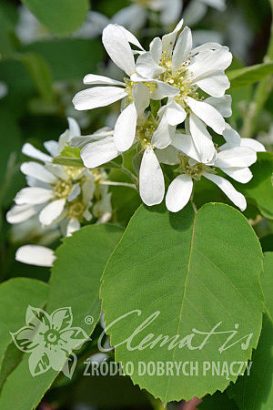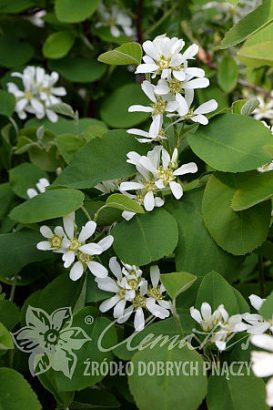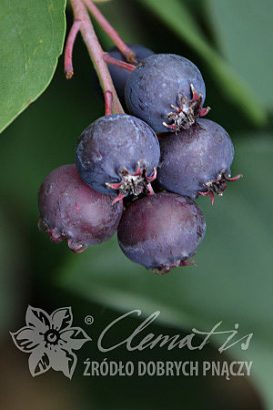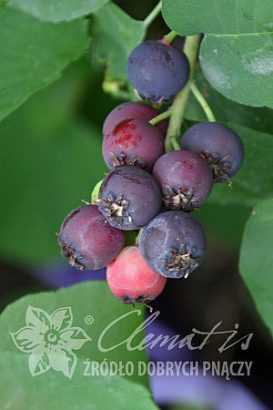Amelanchier alnifolia ‘Pembina’
Saskatoon serviceberry 'Pembina'| Decoration form | leaves, flowers, edible fruits |
|---|---|
| Color of flowers | white |
| Flowering month | IV, V |
| Annual growth | 0.5 m |
| Aspect | sun, 3/4 sun, 1/2 sun |
| Frost hardiness | Zones 5 - 8 |
| Density on 1m2 | 1 |
| Evergreen plant | no |
An ornamental, early-flowering shrub yielding tasty fruit at the beginning of summer. Resistant to freeze and springtime frosts. The cultivar is recommended for house gardens and plantations.
WHAT IT LOOKS LIKE: Leaves ovate, dark green, turn spectacular orange-red colour in autumn Flowers white, gathered in inflorescences; start blooming in IV-V. Fruits are decorative, edible and nutritious berries with a waxy coating – juicy and sweet tasting; dark blue-black when ripe; they ripen in VI–VII. The fruit is borne from the second year after planting.
HOW IT GROWS: A shrub of upright shoots. It reaches 5 m height and is slow-growing – gains 0.5 m annually.
WHERE TO PLANT: Grows and yields fruit best in sunny sites. Tolerates moderate, well-drained soil of neutral or slightly acidic pH. A healthy, robust cultivar, rarely subject to pest. Highly frost hardy (zone 3–8).
HOW TO PLANT AND MAINTAIN: Before planting immerse the plant container in water for 10-30 min. Place the root ball in a 60 x 60 x 60 cm hole with a 10 cm layer of well-rotten manure. Fill the hole with fertile compost soil. Flatten the earth around the plant and cover with bark mulch. Place the root ball as deep as it was in the container, one plant per 1 m². Fertilize from April and water adequately during growing season. The shrub does not require regular pruning. A light pruning can be performed once the plant thickens after a couple of seasons. Excessive pruning limits the fruitification.
HOW TO APPLY: An all-purpose plant suitable for house gardens and park settings. It is suitable for creating high, ungroomed hedges. Recommended for amateur cultivation as well as for commercial plantations (including the ecological ones) The fruit may be eaten raw or processed. They have health-promoting properties, are rich in vitamins, polyphenols, mineral salts, carotenoids and fibre; they have a high antioxidant capacity.
ORIGIN: Barrhead, Canada. Introduced in the market in 1952.








